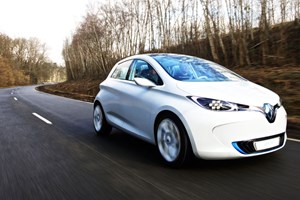Statistics
| How much? | �13,000 |
|---|---|
| Engine: | Electric motor, lithium ion battery, 79bhp, 163lb ft |
| Transmission: | Direct drive, front-wheel drive |
| Performance: | 8.1sec 0-62mph, 84mph, 100mile range, 0g/km CO2 |
| How heavy / made of? | 1392kg/steel |
| How big (length/width/height in mm)? | 4086/1788/1540mm |
Renault says the Zoe concept is 90% identical to the production electric car that goes on sale in early 2012. We get behind the wheel to find what it won�t be like at all to drive.What is the Renault Zoe EV? Is it a Clio replacement?No, the Clio will continue, and there�s a new Clio on the way for late 2012. The Zoe though, is a standalone electric car, albeit one that�s about the same size as the Clio and priced to match a Clio diesel.What the Renault Zoe you see here shares with the new-gen Clio is the new Renault corporate nose. Make no mistake, this is the new face of Renault. You say it�s 90% the car we�ll get in 2012. What�s going to change?The shape is the shape you�ll see in showrooms in 2012, and that�s no bad thing. The Zoe is even prettier in the metal than in pictures, modern and dynamic without being overly aggressive.But Renault is desperate to keep the cost down to around �13k (after the �5k UK Government grant), so we�re not going to see the glitzy lights, glass roof, touch-sensitive door locks and humungous wheels. However Axel Breun, Renault�s concept car design boss, says the budget will allow for suitably large wheels (at least 16in) to retain the show car�s squat stance and the blue tinge to the badge will stay to denote that this is an electric Renault. Are they sure it's not Germans involved in the Renault espionage saga? That's the same stylistic flourish announced by BMW today for its new i3 and i8 electric cars. What�s under the bonnet of the Renault Zoe electric supermini?A 79bhp electric motor; the lithium ion batteries live under the floor to keep the centre of gravity low and reduce the loss of boot and cabin space. While 79bhp doesn�t sound like much, electric motors are all about torque: there�s 163lb ft of twist available meaning 62mph comes up in a very brisk 8.1sec and a 100-mile range, which should be fine for a car designed to live in town.Sounds promising. So what�s the Zoe like to drive?Bloody awful because, like so many concept cars, it�s just a lash-up with a milk float motor designed to look pretty on the show stand, not actually be driven. Besides being incredibly slow, fragile and in this case fitted with heavy and long-winded unassisted steering (the real cars will be electrically powered) it�s also creakier than a pirate ship in a storm.It�s also hard to see out of the Zoe thanks to some terrible reflections in the distorted front screen and those massive high-back seats. Other than the position of the pillars and the shape of the dash, there�s nothing we can glean from driving this car that will give us a clue to what the real car will be like to drive. Unless of course, this is what it�s actually going to be like to drive� But fear not. CAR has driven other Renault electric vehicles, including the Fluence ZE, and they are more mature and sophisticated devices comparable to conventional internal combustion engine vehicles. We hope the same polish will be applied to the Zoe before production. VerdictIf Renault can keep the price down, its pretty electric Zoe could well be a hit with urbanites whose driving habits mean fewer out-of-town journeys. We're about to find out if Renault's electric gamble has paid off. And we have to say that Renault has got a prettier EV on its hands than the mundane Leaf from rivals Nissan. CAR's ratingHandling Performance Usability Feelgood factor Readers' rating |


















































